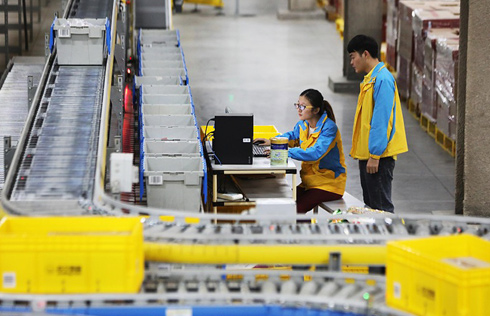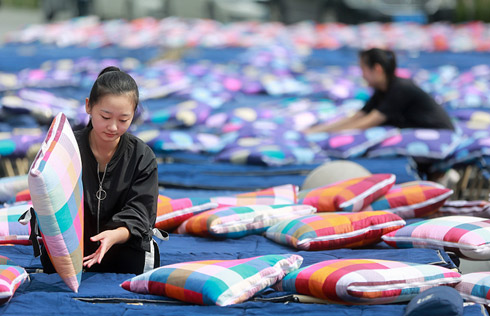FTAAP to inject new energy into regional economic integration
DA NANG - The Free Trade Area of the Asia-Pacific (FTAAP) was brought under the spotlight again this week, as delegates from 21 Asia-Pacific Economic Cooperation (APEC) economies gathered here in Vietnam's Da Nang city for the annual economic leaders' meeting.
The vision to build FTAAP, proposed at the APEC meetings in Hanoi, Vietnam in 2006, was translated into reality at the 2014 APEC meetings in Beijing with the endorsement of a roadmap. A collective strategic study was conducted subsequently and the result was approved at the APEC meetings in Lima in 2016.
APEC members are expected to further discuss issues related to the proposed trade deal at this year's annual meetings.
A report from the Pacific Economic Cooperation Council (PECC) has estimated that the FTAAP, when realized, will add $2.4 trillion to the global economy.
Commitment to multilateralism
The call for accelerating the FTAAP process comes amid slow and vulnerable recovery of the world economy, with the Asia-Pacific region becoming the powerhouse for economic growth.
The World Bank estimated global growth in 2017 to accelerate to 2.7 percent, while East Asia and Pacific, and South Asia take the lead with 6.2 percent and 6.8 percent of projected growth respectively.
However, protectionism and policy uncertainties are still haunting global economic recovery.
"Protectionism is certainly affecting free trade," Tang Guoqiang, international co-chair of PECC, told Xinhua on the sidelines of the APEC meetings. He noted that the global trade growth has been slower than the global GDP growth in the past year, a phenomenon that worries some economists.
The past year has seen some incidents that fueled global concern over protectionism, including the United States' withdrawal from the Trans-Pacific Partnership (TPP) and other multilateral mechanisms. The trend of de-globalization also emerged in other industrialized countries.
"The commitment to multilateralism seemed to have been lost in recent years in industrialized countries," Peter Drysdale, head of the East Asian Bureau of Economic Research and East Asia Forum in Australian National University, told Xinhua.
"And if the APEC economies, most of them, nearly all of them, don't assert that principle very strongly, then the whole rationale upon which the East Asia and Asia Pacific economic prosperity is based will be under threat," he said.
Integrating regional FTAs
The plethora of bilateral and regional trade agreements in the Asia-Pacific region is a testament to both developed and emerging markets' enthusiasm for free trade and open economy. By the end of 2015, some 160 Free Trade Agreements (FTAs) had been signed between APEC members, including over 60 regional FTAs.
But the presence of a complex web of trade deals, known as the "spaghetti bowl" effect, is likely to lead to higher administration costs, while the trade diversion effect may offset the initial gains of FTAs, according to the Collective Strategic Study on Issues Related to the Realization of the FTAAP approved by leaders of APEC members in 2016.
FTAAP, once established, would be the world's largest free trade zone and would "fundamentally solve the 'spaghetti bowl' effect, and serve as a comprehensive and effective institutional framework for regional integration," said Liu Chenyang, director of APEC study center in Tianjin-based Nankai University.
According to Liu, a feasible way to achieve the FTAAP is through "docking, integrating or expanding the large-scale FTAs currently in the making."
These include the faltering TPP which now has 11 members after the United States' withdrawal, and the Regional Comprehensive Economic Partnership (RCEP), which groups the 10 members of the Association of Southeast Asian Nations (ASEAN) and their six major trading partners -- China, Japan, South Korea, India, New Zealand and Australia.
The 21 APEC members, covering some 40 percent of the global population, account for some 60 percent of the world's economy and half of global trade.
An eventual FTAAP could "bring great opportunities for the Asia-Pacific region and create positive externalities for the rest of the world," according to the APEC strategic study.
"FTAAP as a long-range objective for market integration of the Asia-Pacific region, is bound to be welcomed by the majority of countries in the region," said Jin Jianmin, senior fellow at Fujitsu Research Institute in Tokyo.
China's contribution
"With the United States rapidly retreating into protectionism and isolationism, we look forward to Chinese leadership in pushing forward the free trade agenda," said Oh Ei Sun, special adviser for International Affairs of Malaysia's Asian Strategy and Leadership Institute.
Sridharan Nair, territory senior partner of PwC, sees China's drive for FTAAP as "a catalyst for many others to be part and parcel of it."
"Imagine having a pact with China in it versus not having China in it, clearly the former will be much more attractive for the other participant," he told Xinhua on the sidelines of the APEC meetings.
The China-proposed Belt and Road Initiative, which aims to build regional trade and infrastructure networks and boost connectivity, can effectively facilitate regional economic integration and the realization of FTAAP, experts say.
Jayant Menon, lead economist of the Asian Development Bank, said the Belt and Road Initiative is a "key program to increase connectivity within the region, and between the region and the rest of the world."
"Trade costs are directly related to the level of connectivity, and as these costs come down, integration is certain to rise," Menon said.
The core of the Belt and Road Initiative is in many ways in line with that of the FTAAP, according to Chen Dingding, associate dean of Institute for 21st Century Silk Road Studies at Jinan University.
The initiative can help accelerate the realization of FTAAP in economic, political and cultural aspects, while the trade deal would in turn facilitate the Belt and Road development, he added.
"We watched China's Belt and Road Initiative with interest," Alan Bollard, executive director of the APEC Secretariat, told Xinhua. "It's a different sort of development. It's not a regional trade agreement and it's generally not focused on rules and regulations...It's about investment, projects and development of infrastructures."
"We are very interested in that, the bigger initiative goes beyond APEC as well," he added.


























